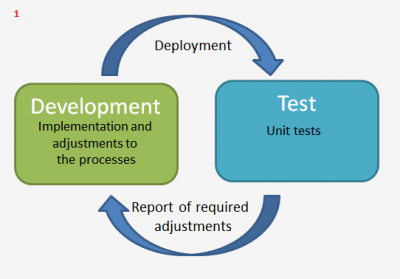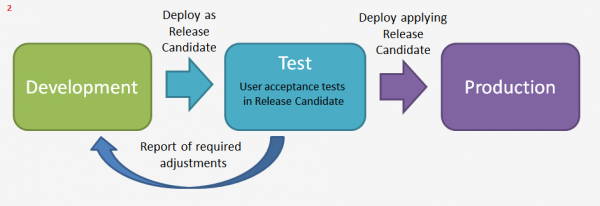Deployment
From Business Process Management, BPM and Workflow Automation Wiki | BizAgi BPMS
<keywords content="keywords"> deployment to production, deploy to production, execute process in production, production environment, create production environment, production, deploy, test, environment, execute, test environment, deployment, publish, publish to production, productive environment </keywords>
|
Applies for the ENTERPRISE .NET and XPRESS editions |
Contents |
Deployment
Deployment of one or more of Bizagi's business processes consists of creating or updating those processes for their execution, in an environment different than the development environment.
This is done once the project's implementation and/or adjustments have been completed in Bizagi Studio.
For a deployment in Bizagi, it is strongly recommended to work with three environments:
Although the previous environment configuration is also the most common, it is also possible to work with two environments as well (the Test environment is optional):
The deployment procedure is done through Bizagi Studio and it is launched in the step 7 of the process wizard (Execute), by selecting the "Deploy Process" option.
Notice that this option becomes available in the process wizard, once there is at least one process in which you have clicked on the "Next" option for step 6.
Alternatively, the deployment window and procedure can be launched too from the Process module (in the Modules View) by right-clicking on a specific process version:
Environments Definition
Bizagi Studio performs itself the one-click deployment procedure by means of the Process Wizard, in which the deployment's configuration is prompted and its execution is carried out online.
A deployment's configuration involves selecting which processes and versions of them, are to be deployed.
In this configuration, the target environment is also specified, along with other options specific for each environment (Test or Production).
The deployment's execution includes the creation of the target environment, which is done automatically by Bizagi Studio for the first deployment to that environment.
According to all this, we present the definition for each of the possible environments considered in Bizagi Studio's one-click deployment:
![]() Development: This is the only environment in which the processes are modeled and its implementation detail is constructed.
Development: This is the only environment in which the processes are modeled and its implementation detail is constructed.
The data model, the forms and the business rules are created in this environment. Also, in this environment the performers and interfaces are defined.
Changes related to the implementation of the afore mentioned, should only be made in this environment using Bizagi Studio.
![]() Test: This environment simulates the Production environment, as it is used to carry out the user acceptance tests of the functionality of the processes versions (certification of the processes).
Test: This environment simulates the Production environment, as it is used to carry out the user acceptance tests of the functionality of the processes versions (certification of the processes).
Processes in the Test environment can be marked as "Release Candidate" so that these processes versions cannot be modified in development.
![]() Production: This is the actual operating environment in which the client's processes are operated by final users.
Production: This is the actual operating environment in which the client's processes are operated by final users.
What happens with the existing cases?
Within a deployment in Bizagi, existing cases of processes in the Development environment are never taken to the Production environment nor to the Test environment (Bizagi does not deploy values stored in master entities).
When a deployment is made to the Production environment, the existing cases in the Production environment will remain the same in that environment.
If a new process' version is deployed to Production, those existing cases will continue to work with the version they were in. New cases created in Production from that moment on, will work with the latest process version.
How to Make a Deployment?
Before launching the deployment procedure, it is recommended to review the previous considerations and requirements for a Deployment of your Bizagi project.
Recommended Deployment Cycle
The following diagrams illustrate the recommended deployment cycle of processes versions:First, deployments to the Test environment are to be made in an iterative way so that required additions and modifications are detected in the Test environment and these are adjusted in the Development environment.
When there are no more adjustments to be made from what observed in the tests carried out in the Test environment, a deployment to the Test environment should be made by specifying that the processes versions are marked as Release Candidate.
Once the Release Candidate processes versions are approved in tests, then the Release Candidate is applied to the Production environment.
Subsequent deployments for continuous improvement of the existing processes, or to publish new processes, should follow this same cycle.
View more about continuous improvement and development after a deployment.
|
Alert: Do not create a Test or Production environment by restoring a database backup of the Development environment. Always use Bizagi's deployment procedure to apply changes of your project into another environment. The deployment executed by Bizagi will ensure that all the business information is kept consistently for your environments. Backups of your environments' databases can be taken (and should be taken) only as a contingency measure. <span lang="ES-CO" /> |
Deployment to the Test environment
It is recommended to perform deployments to a Test environment in order to certify that the processes are ready to be taken to a Production environment.
Deployment to the Production environment
The deployment to the Test environment should be repeated until the processes versions in the Development environment do not need additions or modifications.
Once this is the case, deployment to the Production environment may be carried out.
View a guide for a deployment to the Production environment.
Related Articles
- How to make a Deployment to Test
- How to make a Deployment to Production
- Previous considerations and requirements for a Deployment
- Recommendations for continuous improvement and development after a deployment
<comments />







